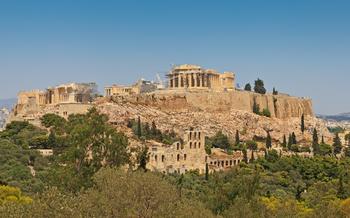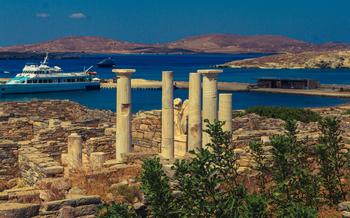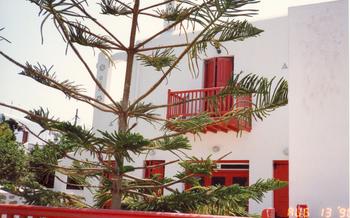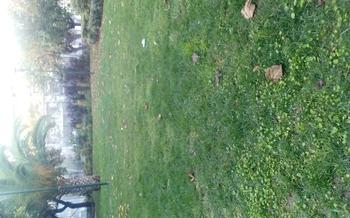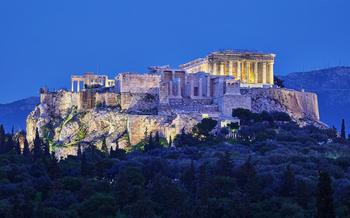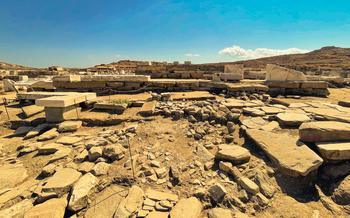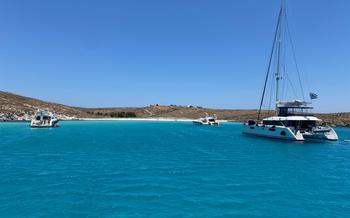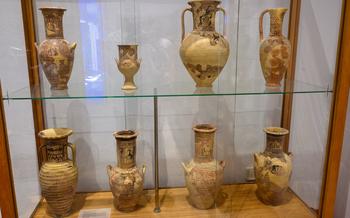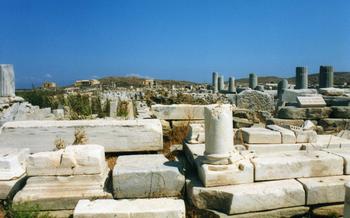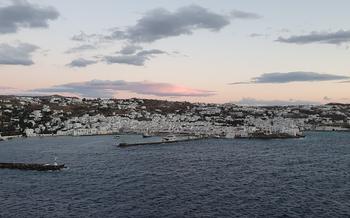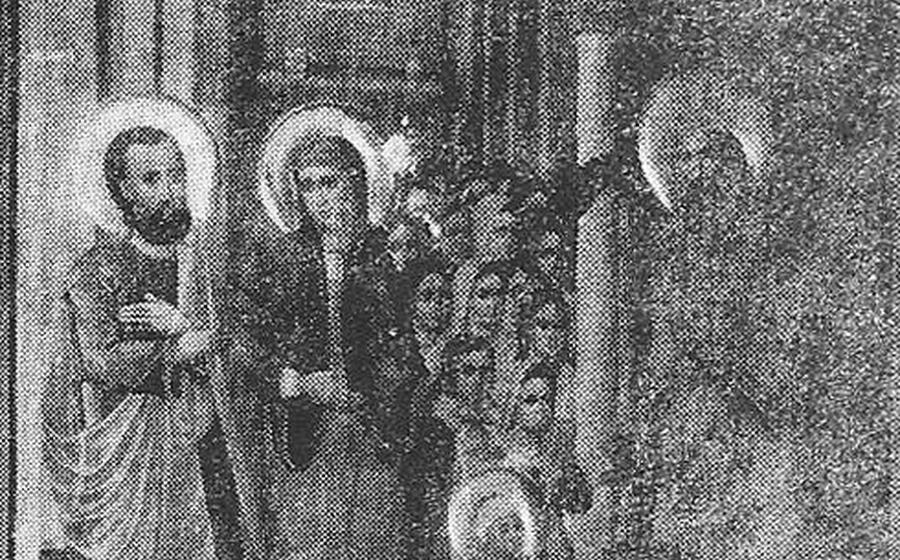
Kastri Archaeological Site
- Explore the Historic Significance of Kastri Archaeological Site
- Architectural Wonders
- Religious Sites
- Theater and Entertainment
- Daily Life and Economy
- Water Management Systems
- Fortifications and Defense Mechanisms
- Sanctuaries and Religious Rituals
- Artisanal Crafts and Workshops
- Public Baths and Hygiene
- Educational Institutions and Learning
- Sports and Athletic Facilities
- Cemeteries and Burial Practices
- Insider Tip
Explore the Historic Significance of Kastri Archaeological Site
Historical Significance: The ancient city of Kastri, founded in the 7th century BC, holds immense historical significance as a strategic military outpost and a vital trade center. It served as a gateway between the fertile plains of Thessaly and the bustling ports of the Aegean Sea. The city's strategic location allowed it to control trade routes and protect against invasions from the north. As a result, Kastri became a prosperous and influential city, leaving a lasting legacy in the region.
The archaeological excavations conducted at Kastri have unearthed a treasure trove of artifacts, including pottery, tools, coins, and inscriptions. These discoveries have provided valuable insights into the daily lives, cultural practices, and economic activities of the city's inhabitants. The ruins of temples, fortifications, and public buildings have further shed light on the city's architectural achievements and its role in ancient Greek society.
Architectural Wonders
Kastri boasts impressive architectural wonders that showcase the ingenuity and skill of its ancient builders. The well-preserved fortifications surrounding the city, with their imposing walls and towers, stand as a testament to the city's strategic importance and its ability to withstand attacks. Explore the intricate details of the ancient buildings, temples, and public structures, which reveal the city's unique architectural style and its influences from various civilizations. Discover the distinctive features that set Kastri apart from other Greek archaeological sites, such as its innovative use of building materials and its creative urban planning.
Religious Sites
Among the ruins of Kastri, the ancient temple dedicated to the goddess Athena stands as a testament to the religious beliefs and practices of the city's inhabitants. Constructed in the 5th century BC, the temple was a sacred place where people came to worship, make offerings, and seek divine guidance. The well-preserved remains of the temple offer a glimpse into the religious life of ancient Kastri.
The temple's imposing presence reflects the importance of Athena, the goddess of wisdom, war, and crafts, in the city's religious pantheon. She was revered as the protector of the city and its people, and her temple served as a central place of worship and devotion. Visitors can explore the ruins of the temple, marvel at its intricate architectural details, and imagine the religious ceremonies and rituals that once took place within its walls.
Archaeological excavations have uncovered a wealth of artifacts related to the temple, including votive offerings, statues, and inscriptions. These artifacts provide valuable insights into the religious practices of the city's inhabitants and their relationship with the divine. The temple of Athena is a reminder of the deep religious beliefs that shaped the lives of the ancient people of Kastri and continues to captivate visitors with its historical and spiritual significance.
Theater and Entertainment
The ancient theater of Kastri is a remarkable testament to the city's vibrant cultural life. Built in the 4th century BC, the theater could accommodate up to 2,000 spectators, who gathered to witness theatrical performances, musical concerts, and other forms of entertainment. The theater's acoustics are exceptionally well-preserved, allowing the audience to experience the same clarity of sound as ancient theatergoers. The stage area features a raised platform and a backdrop of intricate architectural elements, creating a dramatic setting for performances.
Imagine the excitement and anticipation as the audience filled the theater, eager to be transported to another world through the power of storytelling. The actors, adorned in colorful costumes, brought myths, legends, and historical events to life on stage. The theater was not only a place of entertainment but also a platform for social commentary and political discourse. Playwrights used their works to explore contemporary issues, challenge societal norms, and educate the public about important topics.
The theater's design reflects the advanced architectural knowledge of the ancient Greeks. The seating rows are arranged in a semicircle, ensuring that every spectator had a clear view of the stage. The stage itself is elevated, allowing the actors to be seen and heard from all angles. The theater also features a sophisticated drainage system to prevent flooding during heavy rains, demonstrating the attention to detail and practicality of the ancient builders.
Attending a performance at the ancient theater of Kastri is a truly immersive experience that transports visitors back in time. Whether you're a theater enthusiast, a history buff, or simply someone who appreciates the beauty of ancient architecture, this remarkable site is sure to leave a lasting impression.
Daily Life and Economy
Kastri was a bustling center of commerce and trade. The residential areas of the city were a hive of activity, with people going about their daily lives. The remains of shops, workshops, and other commercial establishments can still be seen today, providing glimpses into the economic activities that took place within the city walls.
Inhabitants of Kastri engaged in a variety of occupations. Farmers tilled the surrounding land, producing crops such as wheat, barley, and olives. Artisans crafted beautiful pottery, metalwork, and other goods, which were sold in the city's markets or exported to other regions. Merchants traded with neighboring cities and countries, bringing in new goods and ideas.
The agora, or central public square, was the heart of the city's economic and social life. Here, people gathered to buy and sell goods, discuss politics, and socialize. The agora was also the site of religious festivals and other public events.
The city's economy was closely linked to its strategic location on the trade routes between the north and south of Greece. Kastri served as a major trading hub, facilitating the exchange of goods and ideas between different regions. The city's wealth and prosperity were reflected in the construction of impressive public buildings and the high quality of life enjoyed by its inhabitants.
Water Management Systems
The ancient inhabitants of Kastri demonstrated remarkable ingenuity in managing their water resources. The city's water supply was secured through an intricate system of cisterns and aqueducts that collected, stored, and distributed water throughout the city. These systems were crucial for maintaining the health and well-being of the population, especially during the dry summer months.
The city's water cisterns were strategically located to collect rainwater and runoff from the surrounding hills. These cisterns were carefully constructed using waterproof materials, such as clay and lime mortar, to ensure that the water remained clean and fresh. The cisterns were also equipped with filtration systems to remove impurities and sediment from the water.
To transport water from the cisterns to various parts of the city, the ancient inhabitants built an extensive network of aqueducts. These aqueducts were constructed using stone and clay pipes, which were laid underground to protect the water from contamination and evaporation. The aqueducts were designed with a slight gradient to allow water to flow smoothly and efficiently throughout the city.
The water management systems of Kastri are a testament to the engineering prowess of the ancient Greeks. These systems not only provided a reliable water supply for the city's population but also contributed to the overall health and sanitation of the city.
Fortifications and Defense Mechanisms
Kastri's impressive fortifications stand as a testament to the city's strategic importance and the ingenuity of its ancient inhabitants. The massive city walls, constructed from colossal blocks of stone, once encircled the city, providing a formidable barrier against potential invaders. Along the walls, strategically placed towers served as lookout posts and defensive strongholds, allowing the city's defenders to monitor the surrounding landscape and repel attacks. The city's strategic location atop a hill further enhanced its defenses, providing a commanding view of the surrounding terrain and making it difficult for enemies to approach undetected.
The military prowess of Kastri's inhabitants is evident in the sophisticated defense mechanisms they employed. The city's walls were reinforced with a series of gates, each equipped with sturdy doors and intricate locking systems. These gates could be quickly closed in times of danger, effectively sealing off the city from potential intruders. Additionally, the city's defenders used a variety of weapons and tactics to repel enemy forces, including bows and arrows, javelins, and catapults.
Despite the strength of its fortifications and the bravery of its defenders, Kastri was not immune to attack. Throughout its history, the city faced numerous sieges and invasions, some of which resulted in its capture and occupation. However, the city's strategic location and the resilience of its inhabitants ensured that it remained an important center in the region for centuries.
Sanctuaries and Religious Rituals
Kastri was home to several sanctuaries dedicated to various deities, where religious rituals and ceremonies were performed. One of the most significant sanctuaries was dedicated to the goddess Athena, the patron deity of the city. The ruins of this sanctuary, located on the acropolis, include the foundations of a temple and an altar. Visitors can imagine the solemn atmosphere as ancient worshippers gathered here to honor Athena and seek her protection.
Other sanctuaries in Kastri were dedicated to gods such as Apollo, Zeus, and Artemis. These sanctuaries served as religious centers for the city's inhabitants, who came to pray, make offerings, and participate in religious festivals. Archaeological evidence suggests that animal sacrifices were performed at these sanctuaries, and votive offerings, such as pottery and figurines, have been discovered.
By exploring the ruins of these sanctuaries, visitors can gain insights into the religious beliefs and practices of the ancient Greeks. They can learn about the importance of religion in daily life and the role of the gods in shaping the culture and society of Kastri.
Artisanal Crafts and Workshops
Kastri was renowned for its skilled artisans, who produced exquisite ceramics, intricate metalwork, and other goods. Explore the remains of workshops where these craftsmen plied their trades, leaving behind a legacy of artistry and craftsmanship. Learn about the techniques they used to create beautiful pottery, jewelry, and tools. Discover the importance of artisanal crafts in the city's economy and daily life, as these skilled artisans contributed to the prosperity and cultural vibrancy of Kastri. Admire the remnants of kilns, forges, and workshops, which provide a glimpse into the industrious nature of the city's inhabitants.
Public Baths and Hygiene
Public baths played a crucial role in ancient Greek society, serving as places for both physical cleansing and social interaction. In Kastri, the remains of an impressive public bath complex can be explored, offering a glimpse into the bathing customs and practices of the city's inhabitants.
The baths were typically divided into several sections, including changing rooms, hot and cold plunge pools, and massage rooms. The floors were often heated by a system of underground furnaces, ensuring a warm and comfortable bathing experience. Visitors to the baths could socialize, relax, and receive massages from trained attendants.
Bathing was considered an essential part of maintaining good health and hygiene in ancient Greece. The baths were frequented by people from all walks of life, providing a vital public service that contributed to the overall well-being of the community.
The ruins of the public baths in Kastri are a fascinating reminder of the importance that the ancient Greeks placed on personal hygiene and social interaction. Visitors can explore the well-preserved remains of the changing rooms, pools, and massage rooms, gaining a deeper understanding of the daily lives and customs of the city's inhabitants.
Educational Institutions and Learning
Kastri was not only a military and economic hub but also a center of learning and education. The ancient city boasted several educational institutions where young people from all walks of life could receive formal instruction.
These institutions offered a well-rounded education that encompassed various subjects, including literature, philosophy, mathematics, and rhetoric. The methods of instruction were interactive and engaging, with teachers using lectures, discussions, and hands-on activities to impart knowledge to their students.
Education was highly valued in ancient Greece, and these institutions played a crucial role in shaping the minds of future citizens. They nurtured critical thinking, intellectual curiosity, and a deep appreciation for knowledge and wisdom.
The legacy of Kastri's educational institutions continues to this day, as they stand as a testament to the importance that the ancient Greeks placed on education and the pursuit of knowledge.
Sports and Athletic Facilities
Kastri also boasts impressive athletic facilities, showcasing the importance of physical fitness and sports in ancient Greek society. Explore the remains of the gymnasium, where young men trained and competed in various sports, including wrestling, running, and jumping. Admire the well-preserved palestra, a large open space used for practicing wrestling and other combat sports. Imagine the energy and camaraderie as athletes gathered here to hone their skills and compete for glory. Discover the ancient stadium, a long, narrow track where footraces and other athletic competitions were held. Picture the excitement and cheers of the spectators as they witnessed these thrilling events. These facilities offer a glimpse into the athletic prowess and competitive spirit that characterized ancient Greek culture.
Cemeteries and Burial Practices
Outside the city walls of Kastri, you will find ancient cemeteries where the departed were laid to rest. These burial grounds offer a glimpse into the beliefs and practices surrounding death and the afterlife in ancient Greece. Explore various types of tombs, ranging from simple graves to elaborate structures adorned with intricate carvings and inscriptions. Discover the significance of grave goods, such as pottery, jewelry, and personal items, which were buried alongside the deceased to accompany them on their journey to the underworld. Learn about the rituals and ceremonies performed during burials, shedding light on the deep respect and reverence that the ancient Greeks held for their ancestors.
Insider Tip
To fully immerse yourself in the ancient ambiance of Kastri, consider planning your visit during the off-season, which runs from October to April. During this time, you'll encounter fewer crowds, allowing you to explore the site at your own pace and truly appreciate its historical significance without the hustle and bustle of peak tourist season. The cooler temperatures and tranquil atmosphere will provide a more serene and intimate experience, enabling you to connect with the past and envision the daily lives of Kastri's inhabitants without distractions.
